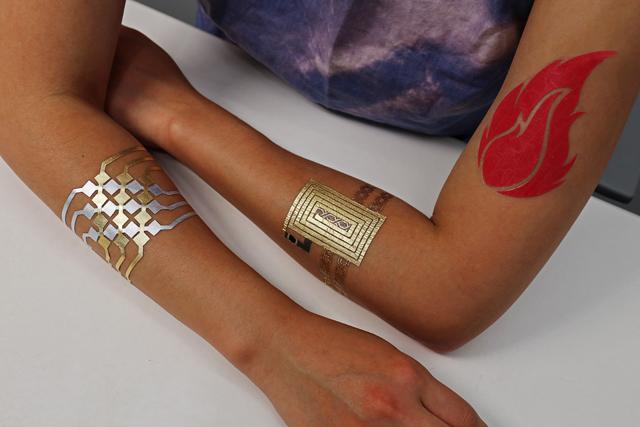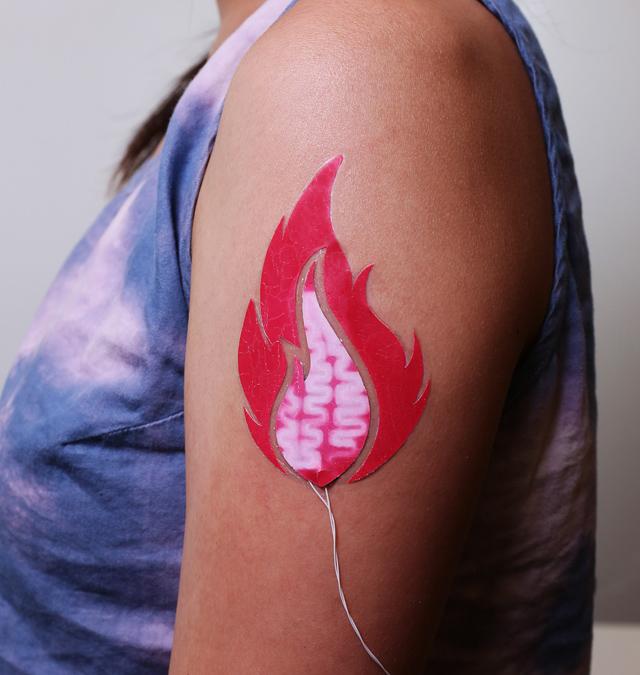Anyone who’s been keeping up with the History channel’s “Vikings” will know that tattoos can make you look like a total badass. Those who’ve seen DC’s most recent cinematic mess, “Suicide Squad,” are aware that tattoos can also turn you into a douchebag who’s trying a little too hard to look edgy (yes, we’re looking at you, Jared Leto).
Now, thanks to the folks at MIT Media Lab and Microsoft Research, tattoos can also transform you into a giant, walking microchip.

Don’t worry; as you can see above, the tattoos look much cooler than they sound. Perhaps more critically, these tattoos aren’t just for show; they also function as wearable interfaces that allow you to interact with a variety of devices. Oh, and they’re not permanent, too, saving you a lifetime of humiliation courtesy of a bad tattoo job.
The high-tech temporary tattoo is called DuoSkin, and is part of a research project involving “on skin” technology. Inspired by temporary metallic/gold leaf tattoos, DuoSkin allows you to design then apply circuits to your skin, creating an on-skin user interface with which to control devices.
From design to application
Making a DuoSkin smart tattoo consists of three steps.
First, you have to design the look of the circuit. You can create said design using any graphics software.
The second and most important step is the fabrication process. This involves cutting the pattern out of vinyl and tattoo paper, then applying gold leaf to the vinyl. Because gold leaf is conductive, the tattoo is sensitive to touch, heat, and electricity.
Lastly, you attach DuoSkin to your skin using the water transfer method—the same method used for ordinary temporary tattoos.
The three classes
The DuoSkin team has proposed three different types, or “classes,” of DuoSkin user interfaces.
The first is the Input type. This transforms the tattoo into a touchpad, allowing you to move a cursor on a computer screen by making swiping motions on your skin, pressing “buttons” by tapping, and the like. The potential of this class is quite amazing: imagine browsing the internet, accessing your digital video player, and making calls by simply stroking or poking your skin!

The second class, Output, is more decorative. Basically, the tattoo changes color depending on your body temperature. Think mood rings, only on your skin.
Of course, Output’s potential goes beyond the ornamental; a tattoo of this class can be specialized to react to a variety of physical phenomena, so it can be of great use in the medical field.
This class uses a thermochromic layer and resistive heating elements to trigger the tattoo’s changes in color.

Third is the Communication class. This uses NFC technology to allow the DuoSkin tattoo to communicate wirelessly. This way, other devices are able to gather data— such as your identity—directly off your skin.
“DuoSkin devices enable users to control their mobile devices, display information, and store information on their skin while serving as a statement of personal style,” stated the team of Cindy Hsin-Liu Kao, Asta Roseway, Christian Holz, Paul Johns, Andres Calvo, and Chris Schmandt.
The future of tattoos
With DuoSkin, tomorrow’s tattoos can be as functional as they are artistic and/or symbolic. Not only can you look like a badass Viking, you can be a badass Techno Viking with the ability to blast your own theme song by caressing your wrist. Or you can be a sad, lonely person who plays video games using your nipple tattoos. The possibilities are only limited by your imagination.

More good news: because DuoSkin uses cheap materials and technology, it’s most likely something everyone will be able to afford.
Those materials also happen to be skin-friendly, so don’t expect to develop any ugly rashes while wearing these tattoos.
“We aim to make durable and skin-friendly on-skin user interfaces available to the wider community, using commodity materials, electronic components, and fabrications processes,” the team said in their paper.
“It is our vision that in the future, on-skin electronics will no longer be black-boxed and mystified; but they will converge towards the user friendliness, extensibility, and aesthetics of body decorations, forming a DuoSkin integrated to the extent that it has seemingly disappeared.”
You can read their entire paper here. — BM, GMA News



